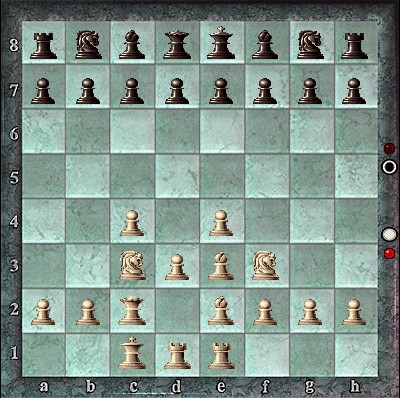|
Hello and welcome to the page that details the Snowflake position on a chessboard.
This position is fairly uncommon and difficult to achieve, but may offer substantial
rewards if it is achieved. Do not go out of your way to achieve this position. However,
sometimes the opportunity presents itself, and then you could possibly attain a similar
position to this one. |
 |
Advantages
- An easy setup, with the twin Bishops becoming potentially dangerous in the middle or
endgame.
- Twin Rooks in the center, looking to force a breakthrough in the later stages of the
game.
- The "Snowflake" is so named because of the cluster of minor pieces around the center,
which resemble its namesake with threats in very direction.
|
Disadvantages
- Both Knights are susceptible to pins, and preventing this with the flank pawns will
consume valuable time.
- A move will be needed to move the King to b1 to avoid the potential skewer from an enemy
Rook.
- The attacking options are quite limited, and the best available weapon should be the
d-pawn, which is supported by the Rooks.
|
|
Move Sequence
- c4. English Opening.
- e4. Bremen Variation.
- Nc3. Overprotecting d5.
- Nf3. Getting the other Knight out
- Be2. Releasing the usual pin on Nf3.
- d3. Releasing the other Bishop.
- Be3. More secure than Bg5.
- 0-0-0. Castling to safety.
- Re1. Getting the other Rook into the center.
- This setup is also relatively fast to put together, and works fairly well in most
situations. d4 would be the subsequent move to crack open the center.
|
|
Pitfalls
Throughout the entire opening sequence, black can give white trouble with these moves:
- d4 is an embarassing Pawn fork on the minor pieces
- f4 serves to box in Be3, and taking it with e4 weakens your center
- Nb4 would force the Queen out, or make it block the d-file for the
Rook
|
Similar Openings
1. c4 e5 is the English Opening.
2. e4 is the Bremen of the
English Opening. |